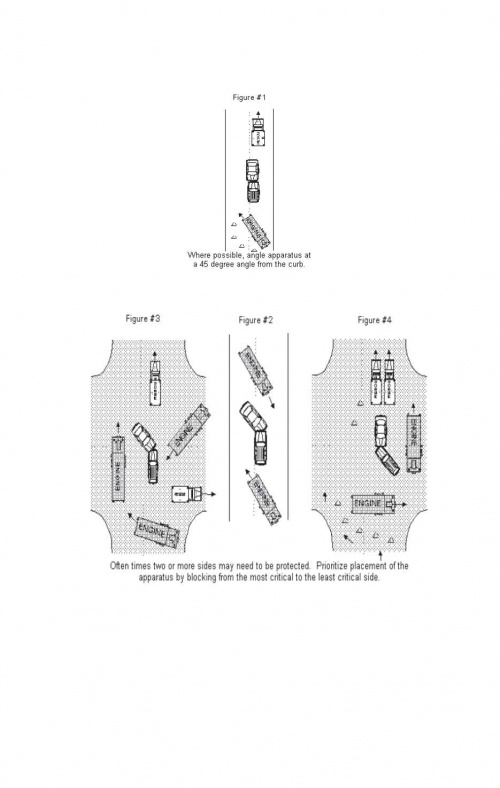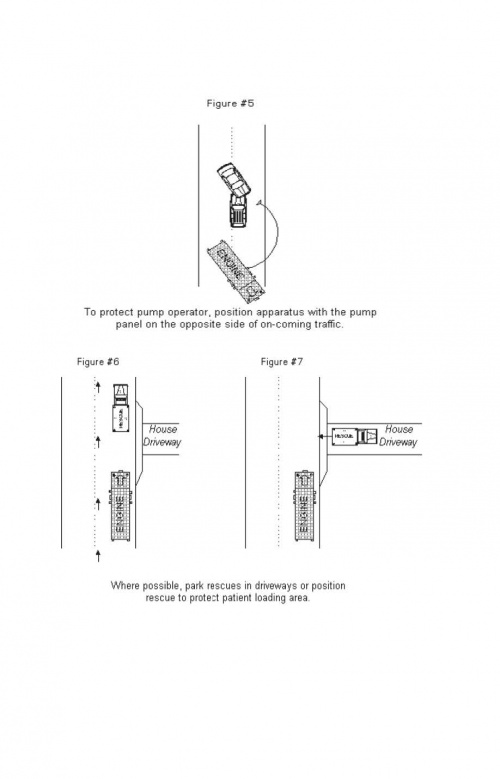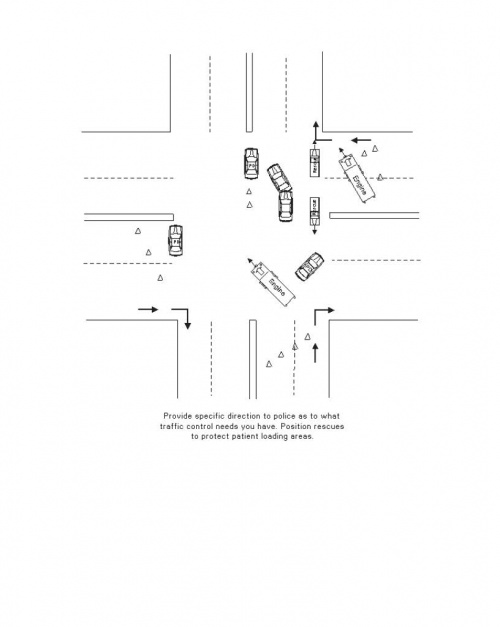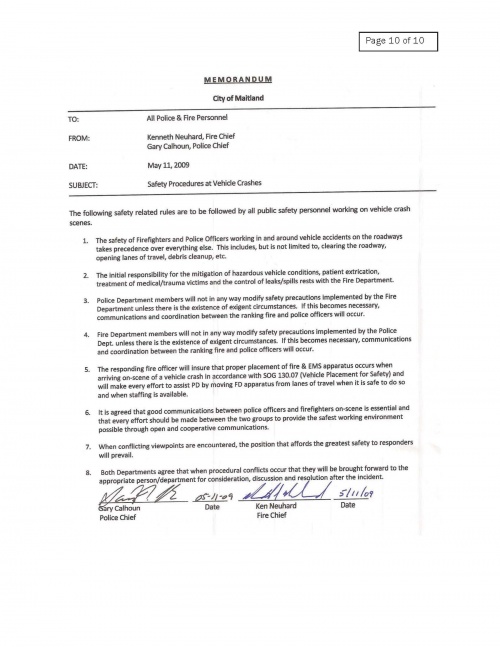Vehicle Placement for Safety
Contents
Section 1 - ADMINISTRATIVE
130.07 Vehicle Placement for Safety and Fend Off Unit Practice
PURPOSE:
To Position Apparatus at the scene of emergencies in a manner that best protects the work area and personnel from vehicle traffic and other hazards; to the extent practical, keeping roadways open and cleaning up debris (See attached Memorandum from Chiefs Ken Neuhard and Gary Calhoun dated May 11, 2009).
DEFINITIONS
The following terms shall be used during incident operations, post-incident analysis, and training activities related to working in or near moving traffic.
- Advance Warning – notification procedures that advise approaching motorists to transition from normal driving status to that required by the temporary emergency traffic control measures ahead of them.
- Block – positioning a fire department apparatus on an angle to the lanes of traffic creating a physical barrier between upstream traffic and the work area. Includes “block to the right” or “block to the left”.
- Buffer Zone – the distance or space between personnel and vehicles in the protected work zone and nearby moving traffic.
- Downstream – the direction that traffic is moving as it travels away from the incident scene.
- Fend Off Unit – A fire department vehicle (principally a pumper truck) with primary responsibility for being staged in such a manner as to protect other units on the scene of an emergency where transient traffic on roadways of all types might be distracted and crash into rescuers and their vehicles.
- Flagger – a fire department member assigned to monitor approaching traffic and activate an emergency signal if the actions of a motorist do not conform to established traffic control measures in place at the highway scene.
- Shadow – the protected work area at a vehicle-related roadway incident that is shielded by the block from apparatus and other emergency vehicles.
- Taper – the action of merging several lanes of moving traffic into fewer moving lanes.
- Temporary Work Zone – the physical area of a roadway within which emergency personnel perform their fire, EMS and rescue tasks at a vehicle-related incident.
- Transition Zone – the lanes of a roadway within which approaching motorists change their speed and position to comply with the traffic control measures established at an incident scene.
- Upstream – the direction that traffic is traveling from as the vehicles approach the incident scene.
PROCEDURE:
Safety Benchmarks for Personnel Operating in or Near Traffic
Emergency personnel are at great risk while operating in or around moving traffic. There are approaches that can be taken to protect yourself and all crew members.
- Never trust approaching traffic.
- Avoid turning your back to approaching traffic.
- Crews should exit the curb side or non-traffic side of the vehicle whenever possible.
- Always look before stepping out of apparatus, or into any traffic areas. When walking around fire apparatus parked adjacent to moving traffic, keep an eye on traffic and walk as close to fire apparatus as possible.
- Always wear Class III high visibility reflective vests during daylight operations.
- Always wear structural firefighting helmet.
- Wear full (Extrication or Structural) protective clothing plus the highway safety vest at all vehicle-related emergencies between the hours of dusk and dawn or whenever lighting levels are reduced due to inclement weather conditions.
- Establish a fire department member assigned to the “Flagger” function to monitor approaching traffic and activate an emergency signal if the actions of a motorist do not conform to established traffic control measures in place at the highway scene.
- Use traffic cones and/or cones illuminated by flares where appropriate for sustained highway incident traffic control and direction.
Apparatus Benchmarks for Safe Operations in or Near Moving Vehicle Traffic
Due to occurrences of near miss incidents, emergency personnel of the Maitland Fire Department should always maintain an acute awareness of the high risk of working in or around moving traffic and protect the scene, themselves, other emergency
responders and the patient through proactive steps including, but not limited to the following:
- Establish an initial “block” with the first arriving emergency vehicle or fire apparatus. The first arriving apparatus should allow 1 foot for every mile per hour of the posted speed limit between the “fend off position” and the “temporary work zone” area.
- Always position apparatus to protect the scene, patients, emergency personnel, and provide a protected work area. Where possible, angle apparatus at 45 degrees away from curbside while turning the front wheels away from the incident scene (See Figure 1).
- During DAYTIME operations, leave all emergency lights on to provide warning to drivers.
- For NIGHTIME operations, turn OFF fire apparatus headlights. This will help reduce the blinding effect to approaching vehicle traffic. Other emergency lighting should be reduced to yellow lights and emergency flashers where possible.
- Establish advance warning and adequate transition area traffic control measures upstream of incident to reduce travel speeds of approaching motorists.
- Place traffic cones at the scene to direct traffic. This should be initiated by the first company arriving on the scene and expanded, if needed, as later arriving companies arrive on the scene. Always place and retrieve cones while facing oncoming traffic.
- Placing flares, adjacent to and in combination with traffic cones for nighttime operations greatly enhances scene safety. Place flares to direct traffic where safe and appropriate to do so. Listed below are general recommendations for the start of traffic cones/flares.
- For first arriving engine companies where a charged hose line may be needed, angle the engine so that the pump panel is “down stream,” on the opposite side of on-coming traffic. This will protect the pump operator (See Figure 5).
- The initial company officer (or Command) must assess the parking needs of laterarriving fire apparatus and specifically direct the parking and placement of these vehicles as they arrive to provide protective blocking of the scene. This officer must operate as an initial safety officer.
- At intersections, or where the incident may be near the middle of the street, two or more sides of the incident may need to be protected. Block all exposed sides. Where apparatus is in limited numbers, prioritize the blocking from the most critical to the least critical (See Fires 2,3 and 4).
- At major intersections police response may be necessary. Provide specific direction to the police officer as to exactly what your traffic control needs are.
- At residential medical emergencies, park Rescue in driveways for safe loading where possible. If driveways are inaccessible park Rescue to best protect patient loading areas. (See Figures 6 and 7).
- Once enough fire apparatus have “blocked” the scene, park or stage unneeded vehicles off the street whenever possible. Bring in Rescue/Ambulance companies one or two at a time and park them in safe locations at the scene.
- Position Rescues to protect patient loading areas (See Figure 8).
Freeway Operations
Freeway emergencies pose a particularly high risk to emergency personnel. Speeds are higher, traffic volume is significant, and motorists have little opportunity to slow, stop or change lanes.
- If possible, keep the freeways flowing. Where need be, the freeway can be completely shut down.
- For freeway emergencies, continue to block the scene with the first apparatus on the scene to provide a safe work area. The first arriving apparatus should allow 1 foot for every mile per hour of the posted speed limit between the “fend off position” and the “temporary work zone” area.
- Other companies may be used to provide additional blocking if needed.
- The initial company officer, or command, must thoroughly assess the need for apparatus on the freeway and their specific positions.
- Companies should be directed to specific parking locations to protect the work area, patients, and emergency personnel.
- Other apparatus should be parked downstream when possible. This provides a safe parking area.
- Staging of Rescue companies off the freeway may be required. Rescues should be brought into the scene one or two at a time. A safe loading area must be established.
- Traffic cones should be placed farther apart, with the last cone approximately 160 feet “upstream, to allow adequate warning to drivers. Place and retrieve cones while facing the traffic.
- Command should establish a liaison with the Department of Transportation as soon as possible to jointly provide resources, a safe parking and work area and to quickly resolve the incident.
- The termination of the incident must be managed with the same aggressiveness as initial actions. Crews, apparatus, and equipment must be removed from the freeway promptly, to reduce exposure to moving traffic.
Fend Off Unit Request and Use
- At the request of the first due suppression unit, an additional unit may be dispatched to assist other units already on scene with fending off vehicles approaching the scene.
- The first arriving company officer (or other qualified personnel in the absence of the company officer) shall make an assessment regarding the need for an additional unit to serve in the fend off capacity. When the need has been established, the appropriate unit will be dispatched. Personnel from the fend off unit will park their unit as appropriate and may further assist with rescue efforts at the scene.
- Response mode (emergency vs. non-emergency) shall be determined and broadcast by the requesting officer.



